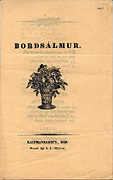Table Hymn |
Borðsálmur |
|
PRECENTOR: We've got so much to bitch about, CONGREGATION: Christ, hear the creature, PRECENTOR: I know a nation, combed and clean, CONGREGATION: Man, what's the matter? Just now the natives feel their oats CONGREGATION: No need to worry They've formed a new committee now, CONGREGATION: Well — time will settle PRECENTOR: This people's enterprise is not CONGREGATION: True, they like drinking PRECENTOR: Incessant slumber makes them pleased; CONGREGATION: Far from surprising The children wear their charming hats CONGREGATION: Mister! I wouldn't |
FORSÖNGVARINN: Það er svo margt, ef að er gáð, FÓLKIÐ: Heyrið þið snáða, FORSÖNGVARINN: Á einum stað býr þrifin þjóð, FÓLKIÐ: Hvað er að tarna? FORSÖNGVARINN: Mér hefir verið sagt í svip, FÓLKIÐ: Við litlu má gera, FORSÖNGVARINN: Nú eru líka níu menn, FÓLKIÐ: Segðu' ekki lengur! FORSÖNGVARINN: Á einum stað býr einnig fólk, FÓLKIÐ: Æ, hvaða skrambi! FORSÖNGVARINN: Þar hefir verið sofið sætt, FÓLKIÐ: Ætli' það sé undur FORSÖNGVARINN: Þar eru blessuð börnin frönsk FÓLKIÐ: Hættu nú herra! |
A Toast to Iceland |
Texts and Commentaries |
The Lay of Hulda |
|---|
